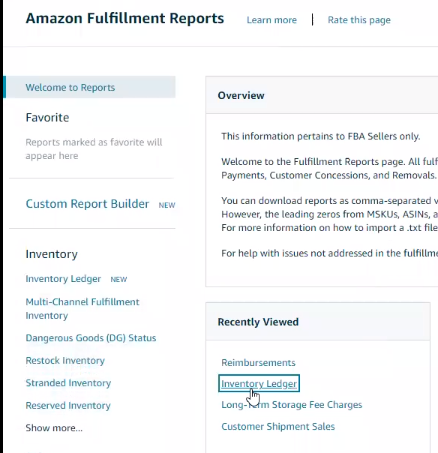Mastering Amazon FBA Reimbursements in 2023: The Comprehensive Guide
10 minute read
In the dynamic world of Amazon FBA selling, understanding reimbursement processes is vital for every seller. As we step into 2023, Amazon's policies continue to evolve, impacting how reimbursements are handled.
In this comprehensive guide, we'll delve into the intricacies of Amazon FBA reimbursements, covering everything you need to know to recover the funds that are rightfully yours.
.png?width=1621&height=1080&name=5%20(1).png)
Why Does Amazon Owe Money to Most FBA Sellers?
Amazon, the e-commerce giant known for its efficiency and seamless operations, occasionally encounters situations where it owes money to its FBA (Fulfillment by Amazon) sellers. While Amazon's vastness and complexity often work in favor of both buyers and sellers, there are moments when the system encounters hiccups, resulting in financial discrepancies that can impact sellers' profits.
Let's delve into these common scenarios, unraveling the complexities behind Amazon owing money to FBA sellers and illuminating the situations where you, as a seller, may be entitled to reimbursement.
1. Amazon Loses Items After Receiving a Shipment at a Warehouse
Picture this: you've diligently prepared your products, carefully packaged them, and sent them to Amazon's fulfillment center. You expect them to be handled with care and precision, ready to meet the eager eyes of online shoppers.
However, despite your efforts, sometimes Amazon might lose these items after they've been received at the warehouse. This situation can be a source of frustration for sellers, especially when inventory mysteriously vanishes into the world of Amazon's vast storage facilities.
In these cases, Amazon owes you more than just an explanation; it owes you reimbursement. The implications of such occurrences can be significant for FBA sellers. When items are lost or damaged after being received at an Amazon warehouse, it not only disrupts your supply chain but can also lead to financial losses.
You might find your inventory mysteriously dwindling, affecting your ability to meet customer demand and potentially damaging your reputation.
Why Does Amazon Lose Product Shipments?

It's natural to wonder why an e-commerce giant like Amazon would occasionally lose entire product shipments. The reasons behind this phenomenon can range from logistical mishaps during the intake process to unforeseen issues within Amazon's extensive warehousing network.
Moreover, it's crucial to recognize that these situations aren't entirely uncommon. While Amazon's efficiency is widely acknowledged, the sheer volume of products it handles daily leaves room for occasional slip-ups. As sellers, it's essential to understand how to safeguard ourselves and our businesses while seeking reimbursement in such unfortunate cases.
2. Uncompensated Damage to Your Inventory
One of the challenges of the FBA system is that, in the hustle and bustle of the fulfillment process, inventory can sometimes suffer damage without the seller being properly compensated. Damaged inventory can translate to financial losses for FBA sellers, as the products may not be sellable in their current state. However, Amazon's reimbursement policy recognizes this issue and offers a way for sellers to seek compensation for such damages.
We'll walk you through the process of identifying damaged inventory, understanding when you're entitled to reimbursement, and how to take the necessary steps to recover the financial value of your compromised products.
3. Overcharged FBA Fees Reimbursement
Amazon's fee structure can be intricate, and errors can occur. Overcharged FBA fees, in particular, can have a significant impact on seller profitability.
Sometimes, sellers find that Amazon has charged them higher referral fees than what's specified in the fee schedule. In these instances, it's vital to be vigilant and understand that you have the right to request reimbursement for these overcharged fees.
It is important to understand the complexities of Amazon's fee structure. Referral fees alone can vary widely, ranging from 8% to 45% of the item's sale price, depending on the product category. These fees are deducted from your sales, impacting your profitability directly.
Additionally, if you use Fulfillment by Amazon (FBA), a host of other fees, such as storage and fulfillment fees, come into play. Incorrect calculations or overcharges in any of these fees can lead to financial discrepancies, affecting your bottom line.
4. Incorrect Measurements
In the world of e-commerce, accurate measurements are crucial for determining shipping costs and fees. However, there are instances when Amazon associates might inaccurately measure your products, affecting your fees and ultimately your profitability.
These measurement errors can manifest in various ways, such as incorrect dimensions or weights of your products. The consequences of these errors can lead to overcharges in your FBA fees, directly affecting your profitability.
For instance, if Amazon associates inaccurately measure your products as larger or heavier than they actually are, you could end up paying higher storage and fulfillment fees. This means you might be overpaying for the services rendered by Amazon.
However, by understanding this aspect of the reimbursement process, you can take action to rectify these errors and ensure that you're not overpaying for fees due to incorrect measurements.
By shedding light on these scenarios, we aim to empower you with the knowledge to identify potential reimbursement claims and navigate the complexities of Amazon's FBA reimbursement processes effectively. Amazon may be vast and efficient, but understanding your rights as an FBA seller and taking proactive steps can help you recover what's rightfully yours in these situations.
What is Amazon's Reimbursement Policy?

The Amazon reimbursement policy is the foundational framework that governs the process of reimbursements for FBA (Fulfillment by Amazon) sellers. It's crucial to gain an in-depth understanding of this policy as it significantly impacts how reimbursement claims are handled and approved.
Amazon's reimbursement policy isn't meant to be a hidden document. However, its intricate details can be challenging to navigate.
The Criteria for Reimbursement
However, there's a certain protocol to follow. Not all lost or damaged items will qualify for reimbursement. To make the cut, your products must meet specific criteria. First and foremost, your items must have experienced their unfortunate fate while residing in Amazon's safekeeping. Second, you must furnish Amazon with a valid FBA reimbursement report, a crucial document in the reimbursement journey.
Now, here's a caveat - Amazon is in the business of efficiency, and they might have a backup plan. If they can replace the lost or damaged item, they might not extend a reimbursement your way. After all, they want you to have your products as swiftly as possible.
The Amazon FBA Reimbursement Process
So, you've found yourself in a situation where Amazon owes you money. Don't worry, it is not an uncommon scenario, and countless sellers have been in your shoes. In these moments, the Amazon FBA reimbursement process becomes your ally, a crucial tool to ensure you reclaim what rightfully belongs to you.
Step 1: Detection of an Issue
Your journey through the Amazon FBA reimbursement process begins with the critical step of issue detection. It's essential to recognize that a problem exists before you can initiate the reimbursement process. These issues can take various forms, such as damaged items, lost inventory, or overcharged fees. However, detecting these issues is not always straightforward, which is why vigilance is key.
Pro Tip: Regularly scrutinize your Amazon reports, with a special focus on the FBA Reimbursements report. This report is a valuable resource that can reveal discrepancies and potential reimbursement opportunities. Keep an eye on it to ensure you don't miss any issues that might be costing you money.
FAQ: Where Can I Find The Reimbursement Report on Amazon?
You can locate the Reimbursement Report on Amazon by following these steps:
-
Log in to Seller Central: Use your Seller Central account credentials to access the platform.
-
Navigate to Reports: Once logged in, go to the 'Reports' tab at the top of the Seller Central dashboard.
-
Select Fulfillment: From the Reports drop-down menu, choose 'Fulfillment.'
-
Access Inventory Ledger: In the Fulfillment Reports section, you'll find the 'Inventory Ledger' option. Click on it to download either a .csv or .txt file.

This report provides a detailed breakdown of any reimbursements owed to you based on various factors, including lost or damaged inventory, overcharged fees, and more. Regularly reviewing this report is a proactive way to identify potential reimbursement claims and ensure you recover funds that rightfully belong to you.
Step 2: Report the Issue
After detecting an issue with your Amazon FBA inventory or fees, the next crucial step is reporting it to Amazon. Fortunately, this process is relatively straightforward and can be initiated directly from your Seller Central account.
FAQ: How to File a Reimbursement Claim in Seller Central?
-
Log in to Seller Central: Begin by logging in to your Seller Central account.
-
In the Seller Central dashboard, navigate to the 'Contact Us' page.
-
Click on “Selling on Amazon issue”.
-
Select “Fulfillment by Amazon”, click on FBA issue.
-
Then provide Details: This is where detailed documentation becomes your ally. Offer a clear and concise description of the problem, including order IDs, ASINs, and any relevant product details.
-
Submit Your Claim: Once you've filled out the necessary information, submit your reimbursement claim. Amazon's team will review your claim and take appropriate action.
Pro Tip: When filing a reimbursement claim, it's essential to provide as much information as possible. This includes photographs, receipts, and any supporting documents that validate your claim. Detailed documentation strengthens your case and increases the likelihood of a successful reimbursement.

Step 3: Wait Patiently
Once you've submitted your reimbursement claim, you'll enter a waiting period. Amazon's team will review your claim to verify the accuracy of your request. It's important to understand that this review process can take some time, and patience is key during this phase.
FAQ: What to Expect During the Waiting Period:
Review and Validation: Amazon's dedicated team will carefully review your reimbursement claim. They will assess the information you provided, check the validity of your claim, and investigate the reported issue thoroughly.
Communication from Amazon: Amazon may reach out to you for additional information or clarification regarding your claim. Be prepared to respond promptly and cooperatively if they require further details.
Processing Time: The duration of the waiting period can vary. It might take a few days to several weeks, depending on the complexity of your claim and Amazon's current workload.
Pro Tip: While you wait for Amazon to process your reimbursement claim, it's essential to maintain vigilance over your Amazon account and transactions. Continue to monitor your inventory, orders, and financial reports regularly. This will help you stay informed about any updates related to your claim and ensure smooth business operations.
Step 4: Review and Confirmation
After you've submitted your reimbursement claim, Amazon will conduct a thorough review. During this critical step, they'll either approve or deny your claim based on their assessment of the provided information. Here's what to expect:
Approval: If Amazon approves your claim, congratulations! You'll receive your reimbursement, and the funds will be credited to your Amazon seller account. This is a significant win, and it represents the successful recovery of funds that are rightfully yours.
Denial: In some cases, Amazon may deny your reimbursement claim. If this happens, don't be discouraged. You still have options. The denial notice you receive will typically provide information about why your claim was denied, allowing you to address the issue and potentially reapply.
FAQ: What to Do If Your Amazon FBA Reimbursement Claim is Denied?
If your Amazon FBA reimbursement claim is denied, here are the steps you can take:
-
Review the Denial Notice: Start by thoroughly examining the denial notice provided by Amazon. The notice should specify the reason for the denial. Understanding the root cause is essential for addressing the issue effectively.
-
Gather Supporting Documentation: If you believe your claim was denied in error or due to missing information, gather any additional documentation or evidence that can substantiate your claim. Ensure that you have comprehensive records related to the issue.
-
Contact Seller Support: Reach out to Amazon's Seller Support team to discuss the denial and provide any supplementary information. Be polite and concise in your communications, clearly explaining why you believe the denial should be reconsidered.
-
Resubmit Your Reimbursement Claim: If Seller Support agrees that your claim was wrongly denied or that additional information is needed, they may instruct you to resubmit your claim with the required documentation.
-
Appeal the Decision: If, after discussion with Seller Support, your claim remains denied, you have the option to appeal the decision. Amazon provides a mechanism for sellers to appeal denied claims. Follow the appeal process, and provide a strong case for why your claim should be approved.
Remember that persistence and clear communication are key when addressing denied claims. Be patient, provide the necessary information, and follow up as needed to seek a fair resolution.
Understanding and mastering the Amazon FBA reimbursement process can significantly impact your bottom line. By staying vigilant, providing detailed documentation, and persisting when necessary, you can recover the funds that are rightfully yours.
Conclusion: Your Ultimate FBA Reimbursement Solution Awaits!
In the ever-evolving world of Amazon FBA, navigating the intricacies of reimbursements is crucial to safeguarding your hard-earned profits. This comprehensive guide has equipped you with the knowledge to understand, initiate, and navigate the Amazon FBA reimbursement process successfully.
Recall these essential takeaways from our journey:
-
Identifying issues that warrant reimbursements is the first step in reclaiming your funds.
-
Detailed documentation and vigilance in monitoring your Amazon transactions are your allies.
-
Amazon's reimbursement policy forms the framework for claims, and understanding it is paramount.
-
The reimbursement process involves detection, reporting, waiting, review, and confirmation.
-
In case of a denial, reviewing the denial notice, gathering evidence, and contacting Seller Support are key steps in seeking a reversal.
Every dollar saved through reimbursements is a dollar reinvested in your Amazon business.
Ready to Optimize Your Reimbursements?
Leverage the expertise of Seller Candy and let our team of Amazon experts navigate the complexities of the reimbursement process for you.
Don't let potential reimbursements slip through the cracks – maximize your bottom line and ensure the prosperity of your Amazon venture.
Start your Amazon reimbursement journey today, and recover the money that Amazon owes you!
